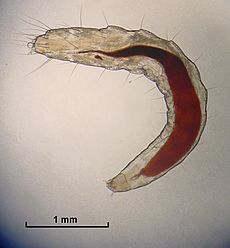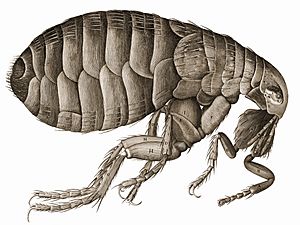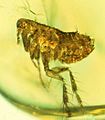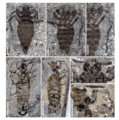Flea facts for kids
Quick facts for kids Flea |
|
|---|---|
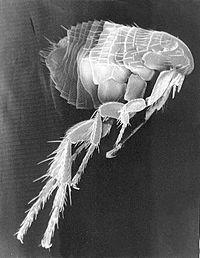 |
|
| SEM of a flea | |
| Scientific classification | |
| Kingdom: | |
| Phylum: | |
| Class: | |
| Subclass: | |
| Infraclass: | |
| Superorder: | |
| Order: |
Siphonaptera
|
| Synonyms | |
|
Aphaniptera |
|
A flea (scientific name: Siphonaptera) is a tiny insect that lives on many different animals, and sometimes even humans! Fleas are known as parasites. This means they live off another creature, called a host. Fleas drink the blood of the animal they bite.
You can find fleas outdoors in sand or tall grass. They can jump onto any animal that passes by and lay their eggs. Flea bites often look like small red bumps and can be very itchy. Fleas can also carry diseases and make animals sick.
There are many types of fleas, like the dog flea, cat flea, and human flea. One type, the oriental rat flea, played a big role in history. Long ago, during the Middle Ages, this flea helped spread a serious illness called the Bubonic Plague. This disease, also known as the Black Death, was a huge epidemic that made many people sick. The fleas would get infected with tiny germs called Yersinia pestis. When an infected flea bit a human, it could pass these germs on.
Contents
What Fleas Look Like and How They Act
Fleas are small insects that do not have wings. They are usually about 1.5 to 3.3 millimeters long. That's about the size of a tiny seed! They are often dark, like the reddish-brown cat flea. Fleas have a special mouth part called a proboscis. It is like a tiny straw that helps them pierce skin and suck blood from their host.
A flea's legs end in strong claws. These claws help them hold onto an animal's fur or feathers. Unlike many insects, fleas do not have big compound eyes. Instead, they have simple eyespots. Some fleas do not have eyes at all! Their bodies are flat from side to side. This shape helps them move easily through hair or feathers. Flea bodies are covered with hard plates. These plates have many hairs and spines that point backward. This also helps them move on their host. Their tough bodies can handle a lot of pressure. This helps them survive when an animal tries to scratch them off.
Flea mothers lay tiny, white, oval eggs. When the eggs hatch, small, pale larvae come out. These larvae look like tiny worms and have bristles on their bodies. They do not have eyes. Their mouth parts are made for chewing. Larvae eat tiny bits of organic matter. They especially like the poop of adult fleas, which contains dried blood. Adult fleas only drink fresh blood.
How Fleas Jump
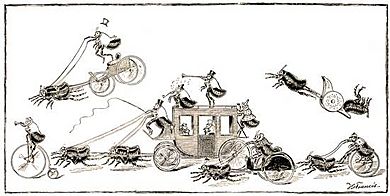
Fleas have long back legs that are great for jumping. A flea can jump up to 18 centimeters (7 inches) high. It can also jump up to 33 centimeters (13 inches) forward! This makes the flea one of the best jumpers in the animal kingdom, especially for its size. Only the froghopper can jump better.
A flea's jump is so fast and strong that its muscles alone cannot do it. Instead, fleas store energy in a special, stretchy pad. This pad is made of a protein called resilin. They release this energy very quickly, like a human using a bow and arrow. Before a jump, the flea's muscles squeeze the resilin pad. This slowly stores energy. Then, the energy is released very fast to push the legs out and power the jump.
Flea Life Cycle and Development
Fleas go through a complete metamorphosis. This means they have four different life cycle stages: egg, larva, pupa, and imago (adult). In most flea types, both male and female fleas are not fully grown when they first appear. They need to drink blood before they can have babies. The first blood meal helps the female's eggs grow. It also helps the male get ready to mate. After this, they usually mate soon.
Some fleas have babies all year long. Others time their activities with their hosts' lives or with the weather. In a group of fleas, about half are eggs. About 35% are larvae, 10% are pupae, and 5% are adults.
Egg Stage
The number of eggs a female flea lays depends on the type of flea. They can lay from two to many dozens at a time. Over her lifetime, a female flea can lay from one hundred to several thousand eggs. In some flea types, the eggs are laid in the host's nest or burrow. In other types, the eggs are laid right on the host. These eggs can easily fall off onto the ground. This means that places where an animal rests or sleeps become a main home for flea eggs and young larvae. The eggs usually hatch in about two days to two weeks.
Larva Stage
Flea larvae hatch from the eggs. They eat any organic material they can find. This includes dead insects, flea poop, other flea eggs, and plant bits. Studies show that larvae need different kinds of food to grow properly. If they only eat blood, only a few larvae will grow up. But if they eat blood and yeast or dog food, almost all larvae will grow. Larvae are blind and do not like sunlight. They stay in dark, damp places. You can find them in sand or soil, in cracks, under carpets, and in bedding.
Pupa Stage
If larvae get enough food, they will turn into pupae. They spin silky cocoons around themselves. Inside the cocoon, the larva changes one last time. It turns into the adult flea. This can take only four days. But it can take much longer if conditions are not good. After this, the adult flea waits inside the cocoon for the right time to come out.
Things that make a flea come out include vibrations (like sounds), heat (from warm-blooded animals), and more carbon dioxide. All these things can mean a host animal is nearby. Many adult fleas can be waiting in cocoons in a place that seems to have no fleas. When a host animal comes, many fleas might pop out at once!
Adult Stage
Once a flea becomes an adult, its main goals are to find blood and have babies. Female fleas can lay 5,000 or more eggs in their lifetime. This helps their numbers grow very quickly. Generally, an adult flea lives for about 2 or 3 months. If a flea cannot find a host to get a blood meal, it might only live for a few days. But if conditions are perfect (good temperature, food, and humidity), adult fleas can live for up to a year and a half.
Fully grown adult fleas can live for several months without eating. This is true as long as they stay inside their puparia (cocoons). The best temperatures for a flea's life cycle are 21°C to 30°C (70°F to 85°F). The best humidity is 70%.
Adult female rabbit fleas can sense changes in a rabbit's blood. These changes tell them when the rabbit is about to have babies. This makes the fleas ready to have their own babies. As soon as the baby rabbits are born, the fleas move to them. Once on the babies, they start feeding, mating, and laying eggs. After about 12 days, the adult fleas go back to the mother rabbit. They do this mini-trip every time she gives birth.
Images for kids
-
How a flea develops from egg to adult. Drawing by Antonie van Leeuwenhoek, around 1680.
See also
 In Spanish: Pulgas para niños
In Spanish: Pulgas para niños



